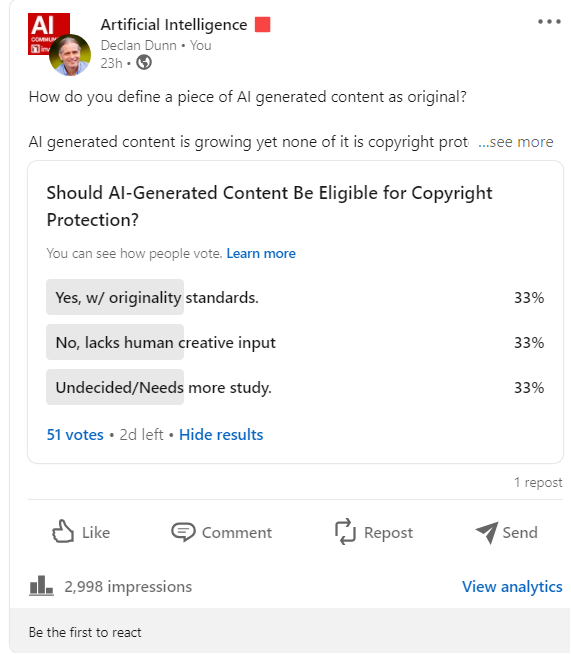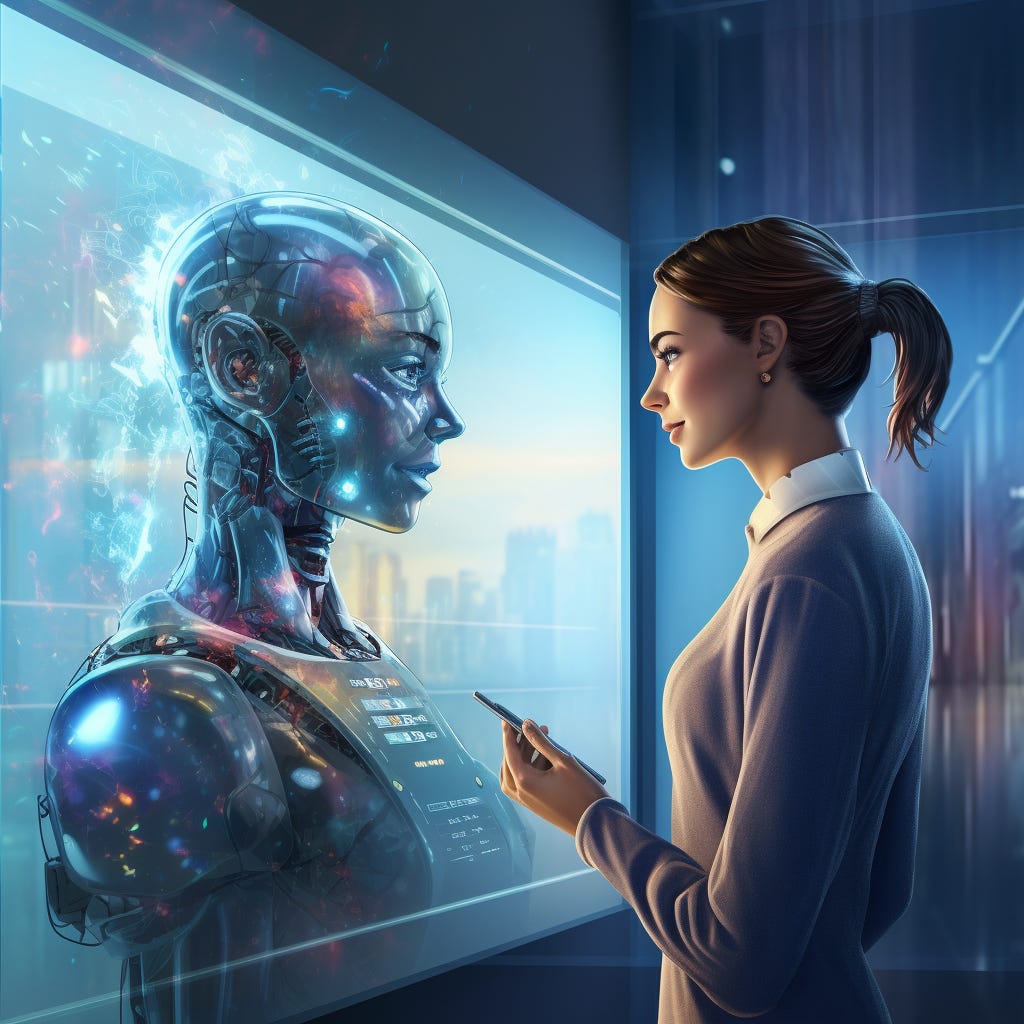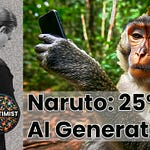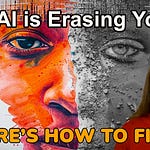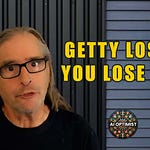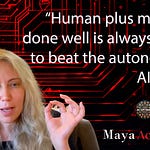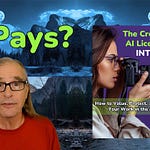Award Winning GenAI Art in 624 Prompts = The Void of Ownership
What Rights Does Copyright Give?
Right now, I can take any art, photo, or writing you create with AI and take it, sell it, and do what I want. Because if it came out with the help of AI, you can’t copyright it.
Want to understand why AI copyrights don’t happen?
It’s like a digital artist, a copyright lawyer, and an art buyer walk into the artist’s gallery…..
The art buyer asks the artist, how much for that AI art you created?
Nothing says the lawyer – it’s AI-generated, so it’s yours for free.
Both digital artists and AI copyright are challenges to traditional notions of artistic creation and ownership.
Digital artists break traditions with their ability to create art unbound by the physical limitations of traditional media.
AI copyright disrupts by developing new forms of intellectual property that do not fit neatly within existing legal frameworks.
And this isn’t a joke; it’s happening now and challenging the notion of copyrights, creativity, and how humans and machines collaborate in AI.
We’ll explore 3 cases of copyrights not given to AI-generated content, what rights you have lost by doing this, and the challenges faced if you do this or use AI content for clients.
Award Winning GenAI Art in 624 Prompts = The Void of Ownership
See that beautiful painting above? I share it without permission; I could sell it to you despite Jason Allen spending time, 624 prompts, extensive Photoshop editing, AND winning an award.
This piece, created with Midjourney, Théåtre D’opéra Spatial, won the Colorado State Fair award in 2022. Stunning work and no one owns it.
The creator, Jason Allen, went to copyright it after the Fair. The Copyright Office turned him down because humans didn’t primarily create that art. He would not disclaim the importance of AI-generated material in his work, claiming:
“the office is placing a value judgment on the utility of various tools.”
While well intended, it needs to be a solid legal argument.
Courts don’t judge tools; they apply existing copyright law. In this case, the author is not human; AI is a machine. No copyright!
Copyright focuses on “expressive elements,” and much of this came from the AI working on Jason’s prompts.
No copyright because it’s not human-generated!
Takeaways – AI Content is Public Domain, meaning no one owns it…..yet.
Despite all his work, the prompting means he’s asking the machine to create the art. Even if he prompts for hours and edits it in Photoshop, the result wouldn’t happen without AI.
AI is not a tool; it’s a co-creator, and the best-case scenario might have been Midjourney, the technology, being granted the copyright.
The Copyright Mistake – Human Authorship is the foundation of the law.
“The Board finds that the Work contains more than a de minimis amount of content generated by artificial intelligence (“AI”), and this content must therefore be disclaimed in an application for registration.
Because Mr. Allen is unwilling to disclaim the AI-generated material, the Work cannot be registered as submitted,” the office wrote in its decision.
“In this case, “disclaim” refers to the act of formally renouncing or giving up any claim to the ownership or authorship of the AI-generated content in the work. The office is saying that because the work contains a non-negligible (“more than a de minimis”) amount of content generated by AI, Allen must formally acknowledge that the AI-generated content is not his own creation when applying for registration.
As established by Copyright Office precedent and judicial review, US copyright registration for a work requires human authorship.”
US rejects AI copyright for famous state fair-winning Midjourney art – Ars Technica
What Rights Does Copyright Give?
Copyright law varies by territory, but in general, copyright gives the owner exclusive rights to:
Reproduce the work: Make copies of the original work.
Create derivative works: Modify the actual work to create something new.
Distribute the work: Share or sell copies of the work.
Publicly display the work: Show the work in public.
Publicly perform the work: Perform the work in public, for example, a play or a song.
License the work: Permit others to do any of the above with your permission.
Without a copyright, there is no ownership, and rights are vague. Even by publicly displaying this art, Allen broke the Colorado Fair rules.
He can’t reproduce, sell, modify, or license it. And he can’t stop anyone else from doing it, as this work is in the public domain, meaning anyone can use it (OK, maybe not sell it).
And if he had, as the Copyright Office said, acknowledged that the AI-generated content is not his creation, he’d lose the case anyway.
My Software Created The Art – Grant It the Copyright, and It will give it to Me.
Stephen Thaler has an unusual approach to copyrighting his work, ‘A Recent Entrance to Paradise”, which also did not receive a copyright, lacking human authorship.
Thaler reapplied for a copyright given to the software that created the art. Judge Howell states that Thaler tries:
“to complicate the issues presented by devoting a substantial portion of his briefing to the viability of various legal theories under which a copyright in the computer’s work would transfer to him, as the computer’s owner; for example, by operation of common law property principles or the work-for-hire doctrine.” United States District Court for the District of Columbia ruling
Thaler lost because he argued about who gets the copyright, not why it should be granted without a human author. Once again, no human authorship, no copyright.
For centuries, authorship in copyright has meant human authorship. The old and current copyright rules won’t protect anything not primarily created by a human being. Proving AI-generated content relies on a human being, as the author, is almost impossible.
Is AI-Generated Content “Fair Use”?
Now, there is one possible angle that OpenAI is trying to use in its many lawsuits, as well as other companies, and that is Fair Use:
John Grisham, George R.R. Martin Among 17 Major Authors Now Suing OpenAI
Getty Images Sues Stability AI Over Photos Used to Train Stable Diffusion Image Generator
Fair use usually refers to works of journalistic or satirical nature. Open AI is now trying to extend this definition to AI.
It’s a problematic fit here as AI gathers many sources to deliver a predictable result, and not one is relied on, so the nature of the work is hard to define.
The key is whether it impacts the copyright owner. As you see above, famous authors and intellectual property owners are flocking to defend themselves against this onslaught of AI on their rights.
Does the artificial intelligence (AI) training process infringe copyright in other works?
“Copyright infringement occurs when one party uses another party’s copyrighted work without permission. Infringement, which takes place both online and offline, includes copying, selling, sharing, publicly performing, displaying, and/or creating derivative works based on a copyrighted work.
A derivative work arises when a body of work is created based on a pre-existing, copyrighted work. Federal courts interpret derivative works differently in part due to various interpretations of the fair use doctrine, which allows for use of copyrighted material without the owner’s permission under certain conditions. Under the fair use doctrine, it is permissible to use portions of copyrighted work for purposes such as news reporting, commentary, and scholarly reports.
Courts determine fair use by the following four factors:
(1) purpose and character of the use,
(2) nature of the copyrighted work,
(3) amount or substantiality of the portion used, and
(4) the economic impact of the use on the copyright owner.: “
Anyone creating AI content faces challenges to their actual work and the impact of their work.
Agencies and service providers who use AI content must disclose this fact to their Clients, meaning that their clients do not gain the copyright to work they paid for.
Work-for-Hire and Copyright
In a work-for-hire scenario, the client expects to own the copyright of the work produced. The agency and the client formalize this through a contract. There are several problems:
Copyright Transfer: If the agency uses human creators, the copyright transfers as usual. However, if the content is AI-generated without copyright, the transfer is not possible.
Liability: Who is responsible for any legal issues if the content is AI-generated and not copyrightable?
Client Expectations: Clients expecting to receive copyright ownership as part of the agreement won’t get it due to the nature of AI-generated content.
Licensing Issues: If the agency uses the content for multiple clients, the lack of copyright makes this legally questionable.
Future Use: If the client doesn’t own the copyright to the AI-generated content, they are limited to future use, such as modification, distribution, and public sharing.
With the wave of companies using AI, even within their companies, how many are reviewing whether it’s legal, leaves them liable, and opens privacy concerns?
Even Amazon requires authors to disclose whether books published are “AI-generated” or “AI-assisted.”
AI-generated means the creation starts and is delivered with AI, while assisted doesn’t have to be revealed, meaning a human created it and then uses AI to help edit and finish it.
Challenges to the Inability to Copyright AI-Generated Content
No Legal Protection or Attribution: Anyone can use AI-generated content without permission, maybe to sell or license. Who’s to say who owns or created the content?
Monetization: If you don’t own the copyright, how can you monetize it legally?
Intellectual Property Right: Without a copyright, there’s no protection for the ideas or creative content.
Plagiarism: While plagiarism is an ethical issue, how can you prove you created it in the first place?
Legal Ambiguity: The legal framework around AI-generated content is still developing, so there are no specific rights today.
No Licensing: If you don’t own it, you can’t license it.
Loss of Control: you can’t control how it’s used or shared.
Ethical Problems: if someone uses your content in an unethical manner or in a context you disapprove of, you don’t have any way to stop them without a copyright.
Zarya of the Dawn – a Ray of Copyright Hope
Kristina Kashtanova’s comic book, Zarya of the Dawn, does show some promise for copyright law.
The Copyright Office rejected the graphic images created for the book with Midjourney, but the actual publication text, organization of images and text, and the document did receive a copyright:
“We conclude that Ms. Kashtanova is the author of the Work’s text as well as the selection, coordination, and arrangement of the Work’s written and visual elements.
That authorship is protected by copyright. However, as discussed below, the images in the Work that were generated by the Midjourney technology are not the product of human authorship.
Because the current registration for the Work does not disclaim its Midjourney-generated content, we intend to cancel the original certificate issued to Ms. Kashtanova and issue a new one covering only the expressive material that she created.” Zarya of the Dawn Letter, Ars Technica
We’re cruising through the 21st century, but our copyright laws are still jamming to the legal records of the past.
This lack of legal clarity throws a wrench into the gears of creativity!
Imagine pouring your heart and soul into a masterpiece, only to find you can’t protect it because the law doesn’t understand your robotic co-pilot.
The cutting-edge algorithms of AI leaders like OpenAI, Microsoft, and Google could drown in a sea of lawsuits. Instead of a new age of art and content, we might follow old rules that don’t understand the power and possibilities of AI.
AI copyright is like a cloud of smoke, challenging to contain and impossible to control.
Until the law catches up to recognizing more than human authorship, it’s a bit like painting on a canvas that erases itself.
Without a copyright, anyone can take your content, call it their own, and sell it. Defining how to copyright AI content and what’s possible is in our next pod.
Until then, step slowly and understand that you don’t own what you create with AI….yet.





